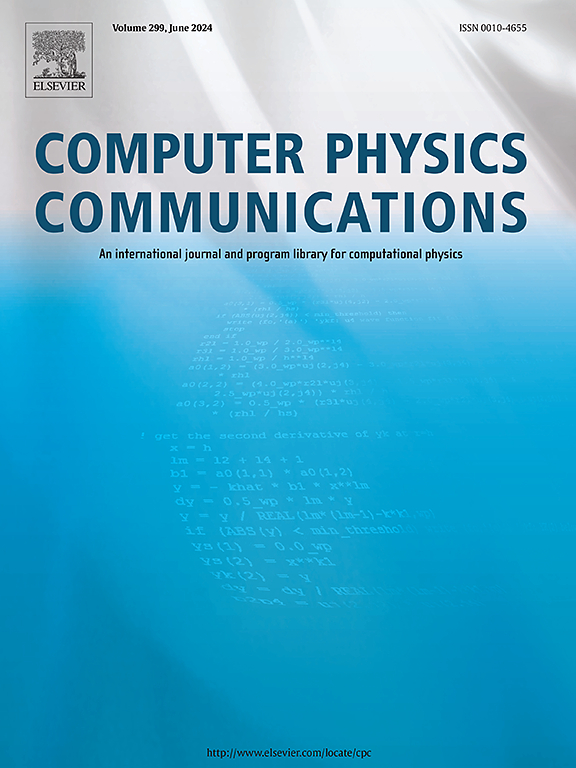具有受限希尔伯特空间或U(1)对称的系统中计算纠缠熵的有效算法
IF 7.2
2区 物理与天体物理
Q1 COMPUTER SCIENCE, INTERDISCIPLINARY APPLICATIONS
引用次数: 0
摘要
本文提出了一种计算受限希尔伯特空间或U(1)对称系统中纠缠熵的有效算法。对于受限的Hilbert空间,该算法简单明了,只需要一个从物理状态到中间矩阵索引的映射表。在具有U(1)对称性的系统中,根据子系统的总电荷对矩阵元素进行适当分组,可以将密度约简矩阵转化为块对角线形式,从而显著提高纠缠熵的计算效率。项目简介项目名称:ResEE。jlCPC库链接到程序文件:https://doi.org/10.17632/d8s5byx96r.1Developer's存储库链接:https://github.com/top2group/ResEE.jlLicensing条款:MIT许可证编程语言:julian问题的性质:计算量子多体系统的纠缠熵与限制希尔伯特空间和/或U(1)对称。求解方法:通过构造映射表来有效地计算具有受限希尔伯特空间的系统的约简密度矩阵。对于U(1)对称系统,利用电荷守恒将约简密度矩阵置于块对角形式,进一步提高了效率。本文章由计算机程序翻译,如有差异,请以英文原文为准。
An efficient algorithm for computing entanglement entropy in systems with a restricted Hilbert space or U(1) symmetry
We present an efficient algorithm for computing entanglement entropies in systems with a restricted Hilbert space or symmetry. For the case of a restricted Hilbert space, the algorithm is straightforward in that only a map table from physical states to indices of an intermediate matrix is needed. In systems with a symmetry, the reduced density matrix can be put into a block-diagonal form by properly grouping matrix elements according to the total charge in the subsystem, leading to a significant boost in the efficiency of entanglement entropy calculation.
Program summary
Program title: ResEE.jl
CPC Library link to program files: https://doi.org/10.17632/d8s5byx96r.1
Developer's repository link: https://github.com/top2group/ResEE.jl
Licensing provisions: MIT License
Programming language: Julia
Nature of problem: Computing the entanglement entropy of quantum many-body systems with restricted Hilbert space and/or symmetry.
Solution method: The program constructs a map table to efficiently compute the reduced density matrix in systems with restricted Hilbert spaces. For symmetric systems, it exploits charge conservation to put the reduced density matrix in a block-diagonal form, further improving the efficiency.
求助全文
通过发布文献求助,成功后即可免费获取论文全文。
去求助
来源期刊

Computer Physics Communications
物理-计算机:跨学科应用
CiteScore
12.10
自引率
3.20%
发文量
287
审稿时长
5.3 months
期刊介绍:
The focus of CPC is on contemporary computational methods and techniques and their implementation, the effectiveness of which will normally be evidenced by the author(s) within the context of a substantive problem in physics. Within this setting CPC publishes two types of paper.
Computer Programs in Physics (CPiP)
These papers describe significant computer programs to be archived in the CPC Program Library which is held in the Mendeley Data repository. The submitted software must be covered by an approved open source licence. Papers and associated computer programs that address a problem of contemporary interest in physics that cannot be solved by current software are particularly encouraged.
Computational Physics Papers (CP)
These are research papers in, but are not limited to, the following themes across computational physics and related disciplines.
mathematical and numerical methods and algorithms;
computational models including those associated with the design, control and analysis of experiments; and
algebraic computation.
Each will normally include software implementation and performance details. The software implementation should, ideally, be available via GitHub, Zenodo or an institutional repository.In addition, research papers on the impact of advanced computer architecture and special purpose computers on computing in the physical sciences and software topics related to, and of importance in, the physical sciences may be considered.
 求助内容:
求助内容: 应助结果提醒方式:
应助结果提醒方式:


